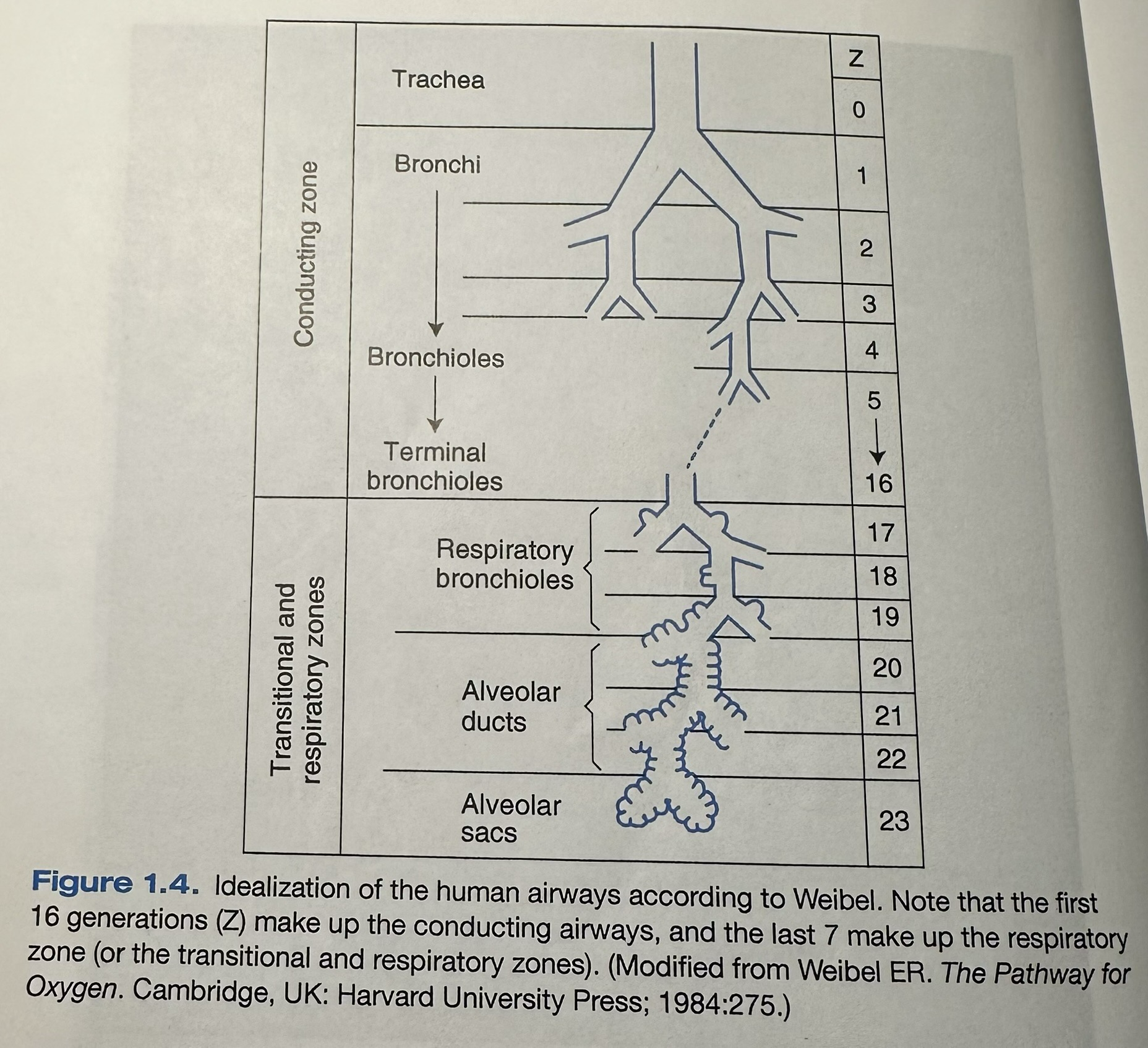West Chapter 1: Structure and Function - How the Architecture of the Lung Subserves Its Function
1/21
There's no tags or description
Looks like no tags are added yet.
Name | Mastery | Learn | Test | Matching | Spaced |
|---|
No study sessions yet.
22 Terms
How do oxygen and carbon dioxide move between air and blood?
By simple diffusion, from an area of high to low partial pressure
Fick’s Law of Diffusion
The amount of gas that moves across a sheet of tissue is proportional to the area of the sheet but inversely proportional to its thickness
How thick is the blood-gas barrier and what is its area?
Thin
Area between 50 and 100 m2
What is the sequence of the conducting zone from largest to smallest?
Trachea → right and left main bronchi → lobar bronchi → segmental bronchi → terminal bronchioles

What is the smallest airway without alveoli?
Terminal bronchioles
Conducting Airways
Function is the lead inspired air to the gas-exchanging regions of the lung
Constitute anatomical dead space because they contain no alveoli and therefore take no part in gas exchange
Dead Space
Areas of lung that receive ventilation but no blood flow
Structures of the Conducting Airways
Larger proximal airways are lined by a ciliated columnar epithelium and have a lot of cartilage in their walls
As airways progress distally, the proportion of cartilage decreases and smooth muscle increases so that the very small distal airways are composed mostly of smooth muscle
What is the sequence of the transitional and respiratory zones zone from largest to smallest?
Terminal bronchioles → respiratory bronchioles (occasional budding from walls) → alveolar ducts (completely lined with alveoli)
Respiratory Zone
Alveolated region of the lung where gas exchange occurs
Makes up most of the lung
Acinus
Portion of lung distal to a terminal bronchiole
How does the cross sectional area of the thorax increase during inspiration?
The volume of the thoracic cavity increases, in part from contraction of the diaphragm causing it to descend and in part from the action of the intercostal muscles which raise the ribs
Where does inhaled dust frequently settle out?
In the terminal bronchioles because the velocity of gas falls rapidly there
What is the dominant mechanism of gas movement in the respiratory zone?
Diffusion of gas within the airways
Rate of diffusion of gas molecules within the airways is so rapid and distances to be covered so short that the differences in concentration within the acinus are virtually abolished within a second
What is the dominant mechanism of gas movement in the conducting zone?
Inspired air flows down to about the terminal bronchioles by bulk flow
Beyond that point, the combined cross sectional area of the airways is so large due to the number of branches that the forward velocity of the gas becomes small
Structure of Blood Vessels in the Lungs
Arteries, veins, and bronchi run close together initially but toward the periphery of the lung, the veins move away to pass between lobules and arteries and bronchi travel together down the centers of the lobules in what is referred to as the bronchovascular bundle
Capillaries form a dense network in the walls of the alveoli
Lengths of segments are short so the dense network forms an almost continuous sheet of blood in the alveolar wall, making it efficient for gas exchange
What can damage the pulmonary capillaries?
Because the blood-gas barrier is so thin, the capillaries are easily damaged
Increasing the pressure in the capillaries to high levels or inflating the lung to high volumes can raise the wall stresses of the capillaries to a point where ultrastructural changes can occur and the capillaries leak plasma and even RBCs into the alveolar spaces
Bronchial Circulation
Additional blood supply for the lung which provides blood to the conducting airways down to about the terminal bronchioles
Most of this blood is carried away from the lung via the pulmonary veins, while a small amount reaches the left side of the heart and enters the systemic circulation
How much time does blood spend in the pulmonary capillaries?
About 0.75 seconds
Role of Surfactant
Because of the surface tension of the liquid lining the alveoli, relatively large forces develop that tend to collapse alveoli
Surfactant dramatically lowers the surface tension of the alveolar lining layer and markedly increases the stability of the alveoli
Removal of Inhaled Particles
Large particles are filtered out in the nose
Smaller particles that deposit in the conducting airways are removed by a moving staircase of mucus that continually sweeps debris up to the epiglottis where it is swallowed or expectorated
Mucus is secreted by mucous gland and also goblet cells in the bronchial walls and is propelled by cilia
Alveoli had no cilia and particles that deposit there are engulfed by macrophages
Foreign material is removed from the lung via the lymphatics or blood flow
Removal of Material from the Pulmonary Blood
The branching network of very small blood vessels traps small pieces of infected material or blood clots which prevents such material from getting to the left side of the circulation where they can travel to various organs and cause problems